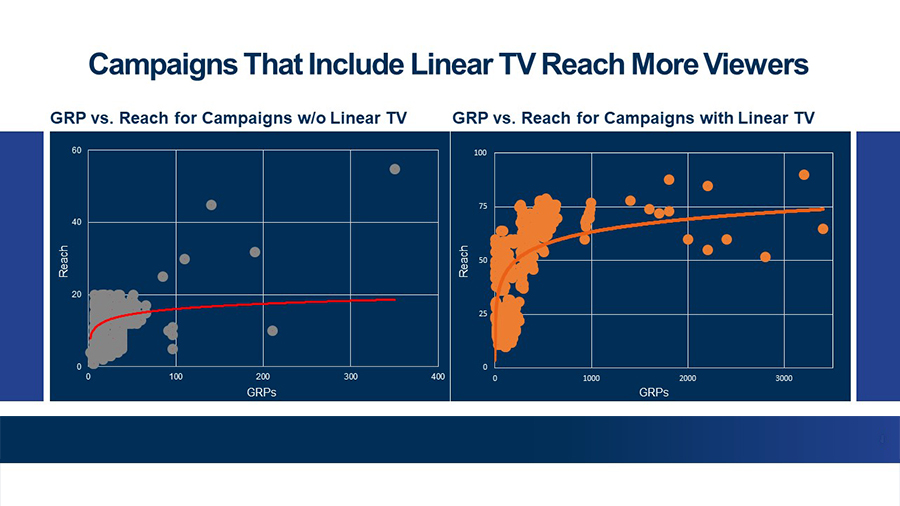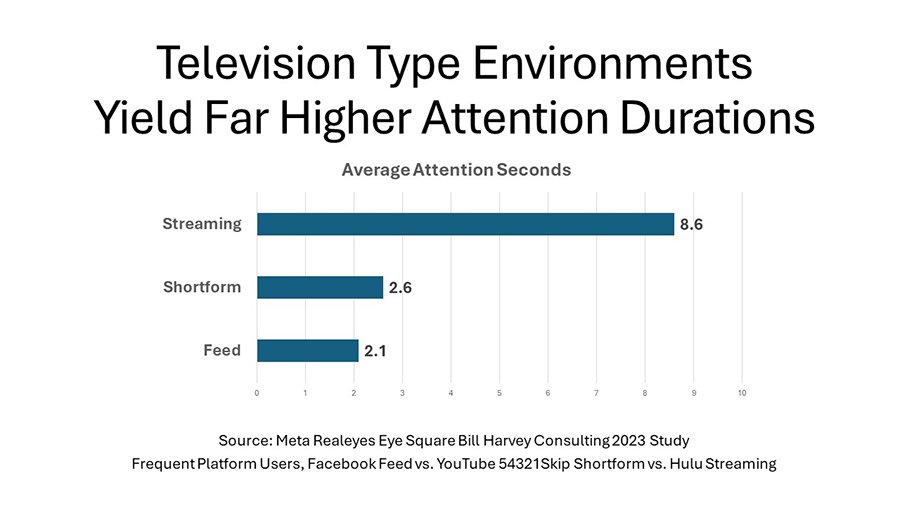The Future of U.S. Local Television

BIA’s U.S. ad spend forecast for all local media, bolstered by the political vertical, plus fastest growth categories real estate, and leisure/recreation, is $172 billion for 2024. Based upon several sources, Bill Harvey Consulting (BHC) is estimating the 2024 political ad spend at $9B for linear and $3.5B for CTV, almost all of which will be local TV. The Olympics will come in at about $1.2B and most of that will go to national TV.
BIA estimates that traditional media receive about half the dollars outside the political category, with the rest going to digital, which is growing fast as local linear declines.
At a national level, Guideline data show that share of ad spend for linear went from 59% in Q1 2017 to 32% in Q1 2024. Local is known to have taken an even greater hit. National and local advertisers have taken half of their local dollars into digital so far and the trend continues. New advertisers are also coming into advertising on the digital side who never felt they could afford TV.
It’s hard to sell local. Even before digital came along, advertisers who put 40% of their TV dollars into spot in the 60s started to put in less and less and some advertisers disappeared from spot, going all-national.
Why is it hard? The CPM is slightly higher (although quite negotiable in reality, and I know one client who got lower CPMs locally than nationally simply by negotiation). And it costs the agency more people hours to buy a million dollars’ worth.
Now the comparison to digital is that it is programmatic and lower CPM and you get tons of data before, during and after. Also your kids applaud you for using their favorite digital media, which is priceless.
Staying the course means accepting that all of the air is going out of the balloon and local TV advertising will become less attractive over time, with lower revenues, able to pay only lower salaries than in the past, and harder and harder to make commissions if you’re a rep or part of an internal sales team.
We don’t have to let this happen. Local TV (and national for that matter) can actually return to its former glory.
The Solutions
1. Learn To Sell Against Digital
Take a crash course. Happy to help. Start with these:
- Nielsen NCS finds that TV has +86% higher ROAS as compared to digital video
- The 10-year BHC FOX study finds that TV has 2.6X the ROAS as compared to digital. This MMM study covered $3 trillion in sales vs. $50 billion in ad spend, making it the largest econometric study in the industry’s history. It also showed that brands as they shifted to digital stopped gaining market share. Where roughly half had been growing prior to the onset of the great shift, today fewer than five are growing.
- Nielsen ONE analysis by FOX shows that at 350 GRP, a campaign without linear TV will tend to top off its reach at 20%, vs. 75% with linear TV.

- Ads on TV average ~15 seconds of attention for 30s and ~8 seconds for 15s vs. 1-2 seconds in scrolling digital or 5 seconds for YouTube 54321Skip where most of the 5 seconds are looking at the Skip button.

- Even Wharton brainwaves show that digital can’t stand up to the sales impact of television.

But don’t stop there. You also have to make a case to the agency media planners and to the advertisers (the CMO’s strategic planners) about local. The Rogers Diffusion Curve is S-shaped, and so each brand finds itself at a different place in that S-curve in each local market. The place where a brand stands to get the highest ROAS is in the fast-growth part of the S-curve. Every station needs to know where its market is in each national brand’s S-curve. This is lost art: I was the discoverer of the data pattern in the early 80s and the ANA informed its members. For a while, spot thrived off this.
In parallel with crash-coursing your rep and internal sales team, selling against digital, you also have to sell your own digital!
Today, all of the growth in local TV is coming from streaming apps and other forms of digital. More than 50 U.S. TV stations/RSNs (regional sports networks) are using Nielsen to measure their streaming app audiences and have the option to have that data included in currency.
If someone asks you why are you now trying to sell them digital when you were a moment ago lambasting digital? It’s because television stays as sweet as it is when it gets delivered digitally. Television as an experience is so good that how it gets delivered means nothing. It fully retains its value.
The real choice you have to communicate to advertisers and agencies is that their ad will be a better experience in TV. Some of it can be the kind of digital TV that is taken from broadcast TV but is now streaming. It must not be limited to streaming because that curtails maximum reach, right now more than half should be linear. And the digital TV that you do buy should be mostly of the professional television variety.
The user-generated kind of digital TV and other digital video forms that have lesser dramatic production quality and mid-level rather than top talent and often mis-present advertising without due respect, do not come close in terms of psychological persuasion power as compared with television. But the brand must include all media types to truly maximize reach.
2. Become Digital Yourself
You must have a streaming app. If you feel you cannot afford it alone, get sponsors and/or join a pan-local scheme.
You should also use all digital channels, all half dozen or more major social media platforms, mobile, branded content, your own website, blog, vlog, YouTube, TikTok. Not just for tune-in but for actual destination content you produce with sponsors. Your station brand should be all over the place. You should present as a digerati.
Going all the way into ATSC 3.0 is the ultimate way to truly become digital through and through. You are addressable, measurable, and interactive. The audiences will be more and more related to purchase/motivation data and less and less to demographics. In ATSC 3.0 you can be switched over from broadcast to IPTV, on the Internet itself! You can do everything digital can do, except you are video professionals, which gives you an edge. That edge will have its greatest effect the sooner you move.
Go programmatic early in the game. Team up to make it easier for the buy side to buy all local as if it is national or global programmatic.
3. Become World Leaders in Measuring Sales Effect
Because television has more sales effect per dollar than digital, it behooves people with a vested interest in television to make sure that sales effects are measured for as many campaigns as possible with those results visible to the sell side on all occasions. The third party measuring that, must have maximum credibility.
4. Have Unique Programming People Want
Brands should always leverage their inherent strengths. What is the inherent strength of local TV? The connection to the community. Therefore team up with the local talent base (including schools and colleges) and create a process that works in your markets to organize an activity of creating local programming with local sponsors.
This is what would have happened 70 years ago if the economies of scale had not temporarily put their thumb on the scale, and for that period of time made it unnecessary for local stations to exert that effort.
The grace period just ended. Time to get into the programming business.
Here are some possibilities to prime your pump:
- Youth sports, ages 13-19. The people in your market care a lot about this topic, their kids or someone they know is involved.
- Local musical, improv, dance, comedy, poetry slams, theatrical and other events you can help create, in some cases the venue being the retail sponsor with adequate space.
- On one of your digital subchannels try running paid 5-minute trailers for new shows end to end. Not just your own shows obviously. Test to see whether you make more than you lose.
- On another subchannel test to see whether you and Solutions Journalism can create a channel all about the people in your market who are living their lives to bring about solutions to the challenging problems the human race faces right now. Call it Local Heroes or something like that. Once you have ATSC 3.0 make it interactive so everyone can participate from wherever they are as if it were a big Zoom meeting.
- On yet another subchannel, have rotating DJs who kibbitz an AI who has a moving, speaking visual image like Max Headroom and answers call-in/write-in questions. Soopra.ai can do that, they run my personal AI which sounds just like me and gives very close answers to my own (but it cannot laugh yet). Try the audio version of my personal AI. Ask it any questions. Imagine what the show would be like, and the AI can take on different appearances.
This is just the beginning of what could be the Next Golden Age of Television.
Full disclosure, I totally believe in these scenarios and already have skin in the game. I’m part of a new consultancy, The NewStar Group, which is working with U.S. Youth Soccer right now to bring youth soccer, boys and girls ages 13-19, into local TV.
We have also linked up USYS with WeAre8, a new form of social media just beginning, which is all about turning social media into a source of light rather than darkness. WeAre8 is already affiliated with national media in the U.S. (Warner Bros. Discovery et al) and in other countries, and seeks affiliations with local media as well.
Do you believe you have enough talent in your market to make great television? I do. That’s the real point isn’t it? Optimizing the advertising and all that other stuff is crucial but the center of the plate is having an audience draw that no one else has.
Posted at MediaVillage through the Thought Leadership self-publishing platform.
Click the social buttons to share this story with colleagues and friends.
The opinions expressed here are the author's views and do not necessarily represent the views of MediaVillage.org/MyersBizNet.


